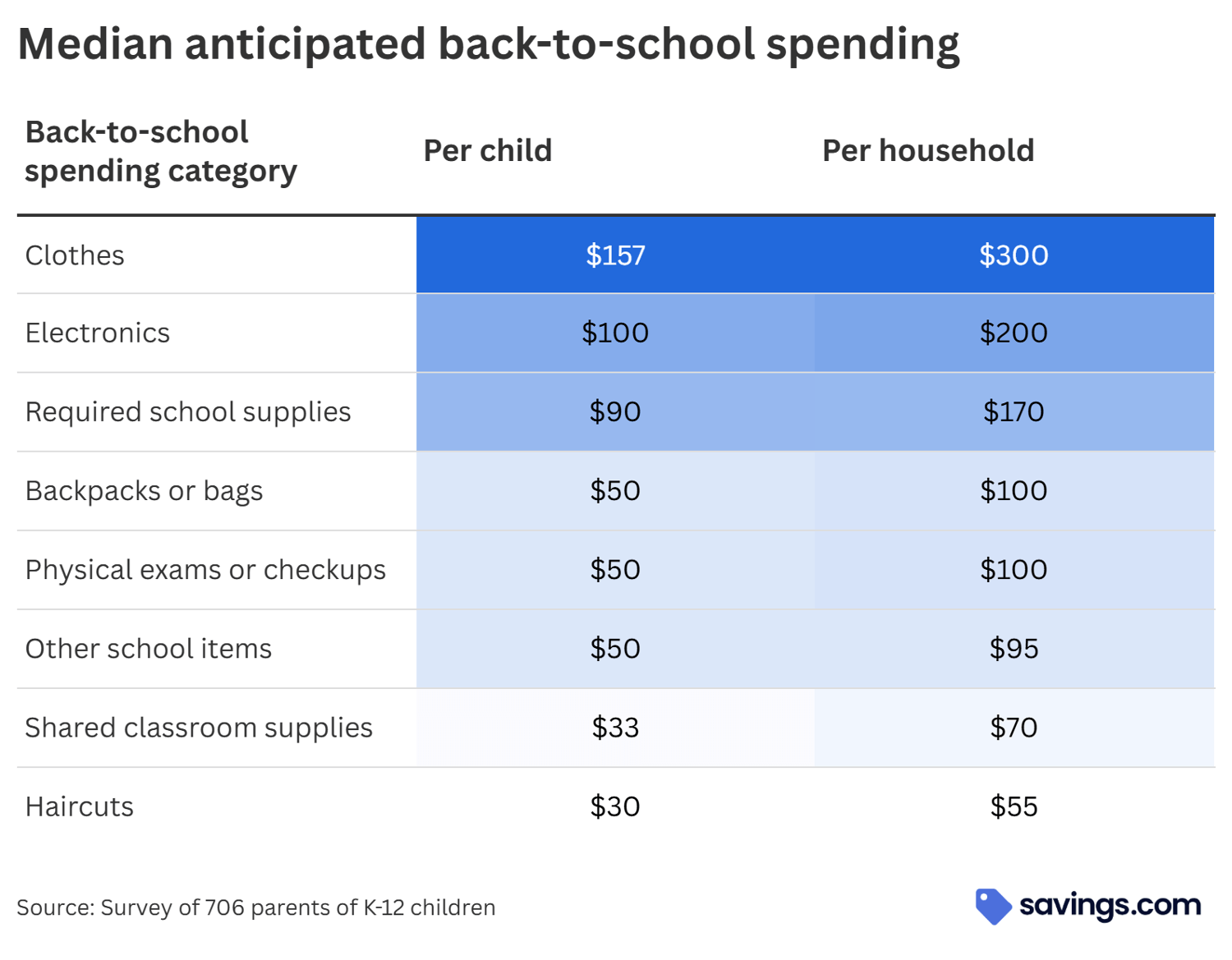
Last Updated: July 15, 2025
Parents will spend a record $628 per child this summer, and 7 in 10 are concerned about the impact of tariffs on school supply prices.
American families are bracing for another year of scorching back-to-school shopping: Parents are set to spend a median $628 per child on supplies, clothing, and tech—a four percent jump from last year and the highest total in four years of tracking, according to a new Savings.com survey.
Key findings from the study:
- 71% of families plan to spend more on back-to-school shopping in 2025 than last year – 7 in 10 are concerned that tariffs will impact prices on the items their kids need.
- Parents will spend an average of $628 per child on new school clothing and supplies, ranging from $620 for elementary students to $800 for high schoolers.
- Clothing will be the most significant back-to-school expense in 2025, followed by electronics and school supplies.
- An increasing number of parents (72%) are taking on work or cutting costs to afford their kids’ school expenses, up from 56% last year.
- 84% of parents plan to save by shopping during their state’s tax-free holidays, which kick off in July.
The spending surge comes even as headline inflation has cooled to 2.1 percent over the past 12 months. But essential kid-shopping categories like footwear, school uniforms, and basic supplies continue running hot, leaving families feeling the pinch where it matters most.
The survey of U.S. parents found that the disconnect between overall inflation and back-to-school costs highlights how specific sectors continue to pressure household budgets despite broader economic moderation.
High Schoolers’ Shopping Lists are Most Expensive, But Elementary Students See the Sharpest Jump
In 2025, 71 percent of U.S. parents expect to spend more on back-to-school shopping this year than last, and the typical parent expects to pay $628 per child or $1,230 per household.
The parents of high schoolers will face the steepest back-to-school bills, expecting to spend around $800 per child. The spending climbs steadily through grade levels: kindergarten through 3rd grade represents the lowest cost at $620 per child, followed by 4th-6th graders at $665, and 7th-8th graders at $718.
However, elementary families are experiencing the most considerable cost increase, with K-3 budgets soaring 26 percent year over year.

Meanwhile, 70 percent of parents worry that inflation and tariffs could impact their ability to buy their kids' supplies. As a result, 72 percent are making sacrifices like cutting expenses or picking up extra work to afford back-to-school shopping, up from 56 percent in 2024.
To afford school supplies in 2025, many parents in the study said they plan to:
- Reduce spending on restaurant meals and non-essential luxury purchases
- Increase income through part-time work, freelancing, or selling handmade items
- Plan purchases strategically by focusing on essential items first and timing purchases around tax-free shopping periods
- Create a dedicated budget and start saving months before back-to-school season begins
- Utilize community support such as clothing drives, school supply donations, or gently used items from friends and family
Where the Money Goes: Back-to-School Spending Breakdown
The survey reveals that necessities make up the bulk of back-to-school budgets. Whether keeping up with fashion trends, accommodating growing youths, or complying with new uniform requirements, parents will spend the most on clothing at $157 per child, followed by electronics at $100 per child and required school supplies at $90 per child.

Families are allocating funds for backpacks ($50 per child), physical exams ($50 per child), and other school items ($50 per child). Even smaller expenses like shared classroom supplies ($33 per child) and haircuts ($30 per child) add to families' financial burden each school year.
Potential tariff policies could significantly impact back-to-school costs, as many essential items like electronics, school supplies, backpacks, and clothing are imported from overseas. Retailers like Nike, Target, and Macy’s have announced price increases that could go into effect this year. If new tariffs are implemented across multiple categories, families could see their back-to-school spending rise well above the anticipated $628 per-child median, adding further strain to household budgets.
Tax Holidays: Mainstream Savings Strategy
Sales tax holidays have evolved from niche perks to mainstream savings strategy, with 84 percent of parents planning to shop during their state's tax-free weekend. States like Florida, Texas, and Tennessee waive four to eight percent sales tax on school items. Below, we’ve compiled a complete list of states with tax-free opportunities. Click on your state to learn more about what types of items are exempt from sales tax:
| State | 2025 dates | What’s exempt from sales tax? |
|---|---|---|
| Mississippi | July 11 – 13 | Clothing, footwear, and school supplies < $100 each |
| Alabama | July 18 – 20 | Clothing items ≤ $100; school supplies ≤ $50; books ≤ $30; one computer ≤ $750 |
| New Mexico | July 25 – 27 | Clothing and footwear items < $100; school supplies < $30; computers ≤ $1,000; computer hardware ≤ $500 |
| Tennessee | July 25 – 27 | Clothing items ≤ $100; school/art supplies ≤ $100; computers and laptops ≤ $1,500 |
| Iowa | August 1 – 2 | Clothing and footwear items up to $100 |
| Virginia | August 1 – 3 | School supplies ≤ $20; clothing or footwear ≤ $100 each; plus hurricane-prep and Energy-Star items |
| Missouri | August 1 – 3 | Clothing items ≤ $100; school supplies ≤ $50 per purchase; software ≤ $350; personal computers ≤ $3,500; graphing calculators ≤ $150 |
| Oklahoma | August 1 – 3 | Clothing and footwear items < $100 |
| South Carolina | August 1 – 3 | Clothing, footwear, all school supplies, bookbags, computers/printers, and dorm items like linens — no price caps |
| West Virginia | August 1 – 4 | Clothing items ≤ $125; school supplies ≤ $50; instructional materials ≤ $20; laptops/tablets ≤ $500; sports equipment ≤ $150 |
| Ohio | August 1 – 14 | Nearly all tangible personal property ≤ $500 |
| Florida | August 1 – 31 | Clothing, bags and footwear items ≤ $100; school supplies ≤ $50; learning aids ≤ $30; personal computers ≤ $1,500 |
| Arkansas | August 2 – 3 | Clothing items ≤ $100; accessories ≤ $50; all school, art, and instructional supplies and electronics (no cap) |
| Texas | August 8 – 10 | Clothing, footwear, backpacks, specified school supplies — each < $100 |
| Maryland | August 9 – 15 | Clothing and footwear items ≤ $100 and the first $40 of backpacks/bookbags |
| Massachusetts | August 9 – 10 | Most tangible personal goods≤ $2,500 |
| Connecticut | August 16 – 22 | Clothing or footwear up to $300 |
Parents Opt for Generic Brands and Secondhand Goods While Maximizing Membership Benefits
Besides shopping during tax holidays, here's how else parents are approaching back-to-school shopping:
- Buying secondhand and used items—Second-hand shopping has gone mainstream, thanks to rising living costs and resale apps like Poshmark. Nearly half of parents (48 percent) may purchase at least some used back-to-school items.
- Selecting generic and store brands—Almost half of parents (49 percent) now prefer generic supplies like store-brand notebooks and markers, especially when membership discounts make them more appealing. Many opt for Walmart’s Pen + Gear brand or Target’s Up & Up label.
- Maximizing membership program benefits—With 87 percent of parents holding Amazon Prime and 69 percent using Walmart+, families are timing purchases around member-exclusive sales and taking advantage of free shipping perks.
- Timing purchases around major sales events—Not every state has tax holidays, so many parents wait for Prime Day and competing "Black Friday in July" events from retailers like Target and Best Buy before making big-ticket purchases like laptops or calculators.
What's Next For Student Spending?
If current trends persist, next year's back-to-school spending could break $650 per child unless school districts shorten supply lists or tariff pressure eases further.
In the meantime, major retailers like The Children’s Place and Old Navy try to relieve the cost burden by offering deals and bundles on uniforms and casual clothes during the back-to-school shopping season.
In addition, parents are getting creative—shopping earlier, buying used, and leveraging every membership benefit and tax break available. However, record spending levels raise questions about how long families can sustain these strategies before something gives.
The Savings.com survey was conducted online in June 2025 and included 706 U.S. parents of K-12 students.
